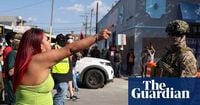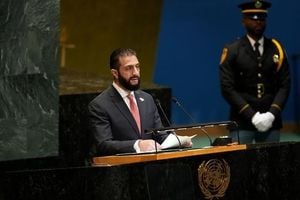On October 4, 2025, the city of Portland, Oregon, found itself at the center of a heated national debate over the use of military force in American cities. What began as a series of nightly protests outside a U.S. Immigration and Customs Enforcement (ICE) facility escalated into a legal and political showdown between the Trump administration, local officials, and a federal judiciary determined to uphold constitutional boundaries.
Protesters had been gathering outside the downtown ICE facility for months, voicing opposition to President Donald Trump’s mass deportation agenda. While some demonstrators attempted to block vehicles entering and exiting the property, the majority of gatherings were peaceful, dispersing quickly during the day. At night, however, federal officers often responded with tear gas and other crowd-control tactics to clear the area. According to Portland police, 27 arrests were made since early June, with federal officers detaining at least two dozen more during the demonstrations (Common Dreams).
Despite the relatively minor disruptions, the White House described Portland as “war-ravaged,” claiming the city was under siege from violent left-wing groups. On September 28, Defense Secretary Pete Hegseth announced that 200 National Guard troops would be deployed “immediately” to Portland. Yet, by early October, local news outlets like KGW reported that no such deployment had occurred, sparking confusion and concern among residents and officials alike (Hindustan Times).
The Trump administration’s rationale for sending troops was quickly challenged in court. U.S. District Judge Karin Immergut, herself a Trump appointee, issued a temporary restraining order blocking the deployment. Her ruling was pointed: “The White House’s claims about ‘war-ravaged’ Portland are untethered to facts,” she wrote, adding that the protests at the ICE facility “were not significantly violent or disruptive in the days—or even weeks—leading up to the president’s directive.” Judge Immergut emphasized that the threshold for deploying federal troops—foreign invasion, rebellion, or local authorities’ inability to maintain order—had not been met. “The protests have been such a minor issue that the normal nightlife in downtown Portland has required more police resources than the ICE facility,” she noted (Common Dreams).
Immergut’s decision was celebrated by Oregon officials. Governor Tina Kotek declared, “Today’s ruling validates what Oregonians already know: justice has been served, and the truth has prevailed. There is no insurrection in Portland. No threat to national security. No fires, no bombs, no fatalities due to civil unrest.” Oregon Attorney General Dan Rayfield echoed this sentiment, condemning the administration for attempting to “normalize the use of military force” in American cities. “Portland isn’t a war zone. It’s a city full of people biking to work, paddleboarding on the Willamette and brewing kombucha,” Rayfield said (Star Tribune, The Guardian).
Yet, the administration pressed on. That same evening, it appealed Judge Immergut’s ruling to the 9th Circuit Court of Appeals—an institution that had previously sided with Trump on similar deployments in other cities. Meanwhile, behind the scenes, discussions of even more dramatic measures were underway.
Leaked private messages from Anthony Salisbury, a deputy to senior Trump adviser Stephen Miller, revealed that officials were considering deploying the Army’s elite 82nd Airborne Division to Portland. Salisbury was photographed in Minnesota using the encrypted app Signal to discuss the plan with Patrick Weaver, a senior aide to Defense Secretary Hegseth. Weaver reportedly wrote, “Between you and I, I think Pete just wants the top cover from the boss if anything goes sideways with the troops there,” referring to President Trump. Weaver also admitted that sending the 82nd Airborne—typically America’s top quick reaction force for foreign missions—would “cause a lot of headlines” (Hindustan Times).
The 82nd Airborne Division, based at Fort Liberty in North Carolina, has a storied history, having parachuted into combat during both World Wars and participated in conflicts from Vietnam to Afghanistan. Its deployment on U.S. soil, especially in a domestic protest context, would be unprecedented and highly controversial. As Weaver pointed out, Defense Secretary Hegseth would have preferred to send the National Guard due to the expected backlash over using regular army troops (Hindustan Times).
News of these discussions sparked outrage among politicians in Oregon and Minnesota. U.S. Representative Suzanne Bonamici of Oregon said, “These leaked messages make it blatantly clear that the decision to send troops to Portland is based on political optics, not safety. Portland does not want or need any troops, let alone the elite 82nd Airborne unit. And it’s absurd—and dangerous—that this incompetent administration is still discussing supposed national security plans on Signal.” Minnesota Senator Tina Smith added, “Trump’s use of the military as a political weapon is dangerous and un-American” (Star Tribune).
Amid the uproar, the Trump administration’s top adviser, Stephen Miller, escalated his rhetoric, accusing Judge Immergut of “legal insurrection” and claiming that “there is a large and growing movement of left-wing terrorism in this country” shielded by “far-left Democrat judges.” Miller insisted, “The only remedy is to use legitimate state power to dismantle terrorism and terror networks.” California Governor Gavin Newsom dismissed Miller’s remarks as “authoritarian propaganda, plain and simple,” and called for his firing (Common Dreams).
In tandem with the legal battles, President Trump signed an executive order declaring “antifa” a “domestic terrorist organization”—despite the lack of any formal antifa organization—and issued National Security Presidential Memorandum 7 (NSPM-7), which mandates a national strategy to investigate and disrupt entities suspected of fomenting political violence. Miller announced plans to apply NSPM-7 in Portland, stating that investigations into so-called “domestic terrorist networks” would be launched whenever federal agents made arrests at protests (Common Dreams).
The controversy over Portland was not isolated. On the same day as Immergut’s ruling, Trump authorized the deployment of 300 National Guard troops to Chicago, citing “ongoing violent riots and lawlessness.” Illinois Governor JB Pritzker condemned the move as “a manufactured performance—not a serious effort to protect public safety” (The Guardian).
For many in Portland and beyond, the events of early October 2025 highlighted the deep divisions in American politics and the enduring tension between civil liberties and public order. As Judge Immergut succinctly put it, “This is a nation of constitutional law, not martial law.” With appeals pending and the threat of further military interventions looming, the outcome of this legal and political standoff remains uncertain—but its implications for American democracy are undeniable.




